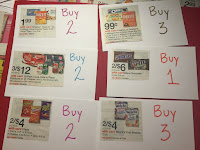 |
| You will need index cards, scissors, glue and store ads. |
 |
| Cut out items on sale from the store ad. I tried to chose items that I know my students would be interested in. |
 |
| Next, glue them onto index cards. Try to glue them so that you will have room to write on a section of the index card. Also, only glue one per card. |
 |
| You have two options to choose from for this next part. You can either use markers to write on the cards or you can print out the info and glue it onto the cards. I chose the easier one. :D |
 |
| Here is what I came up with! Notice, on some of the cards students will have to determine unit rates. |
Here are some more examples for you.
How do you play "Spend It All"?
Number of players: 2 to 4
Materials: Paper, pencil and one set of "Spend It All" cards.
Directions: Place cards face down on the center of the table. Each player starts with $100. Player 1 takes a card from the top of the stack. This represents a purchase. The card will state the number of items the player must buy. The player will then subtract the amount from their $100. Player 2 then repeats the same process. Each player will have different cards (purchases) each time. The player to "Spend It All" first is the winner!!!
Here are some closer looks at the cards. Hopefully it will give you some ideas! :D
I truly hope this activity is helpful and of use to you! I think that it is good to have students work with something they see everyday outside of school, such as these ads. That way, they can actually realize that math IS important to learn and that they WILL use it in their daily life.




















































